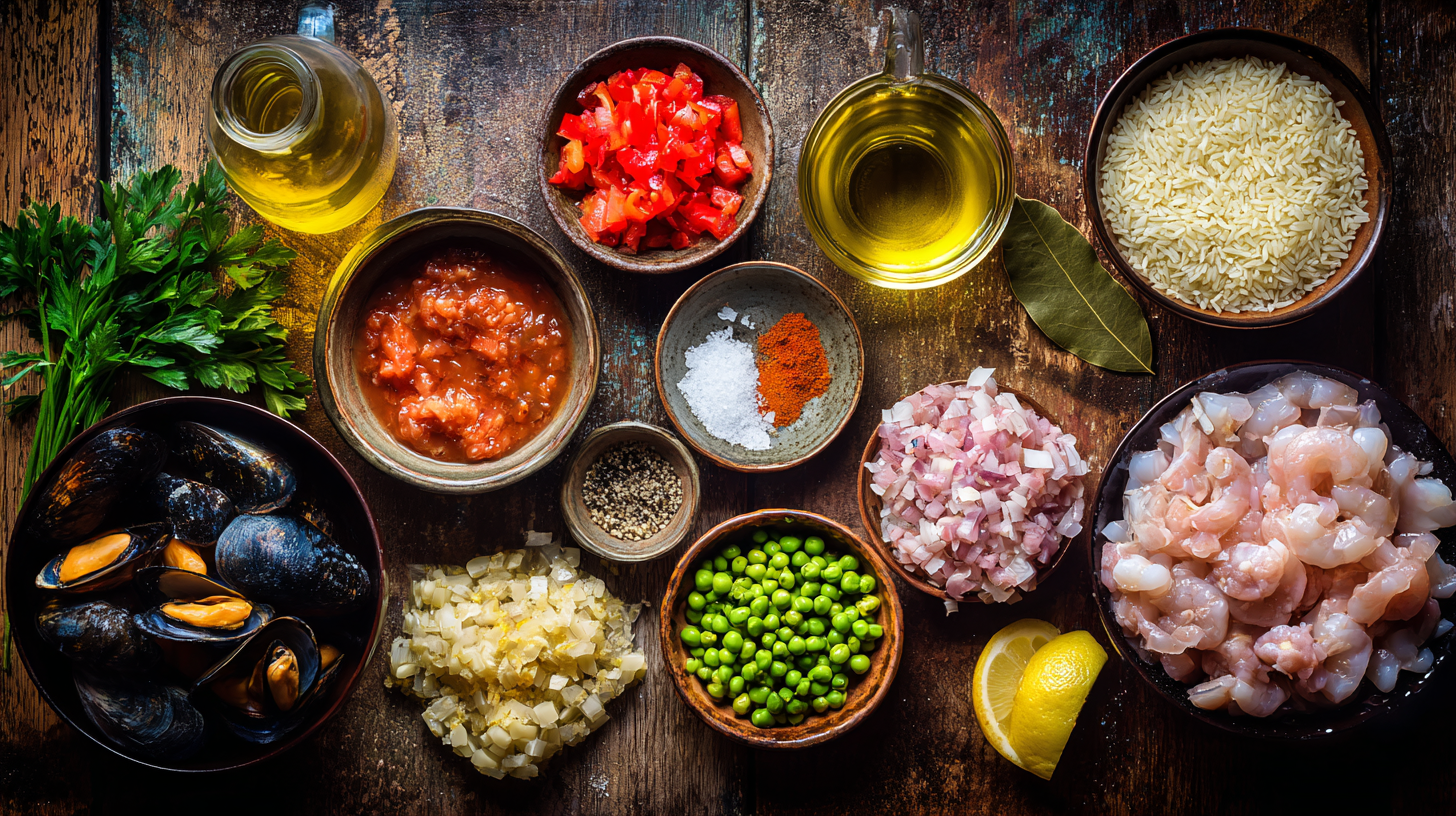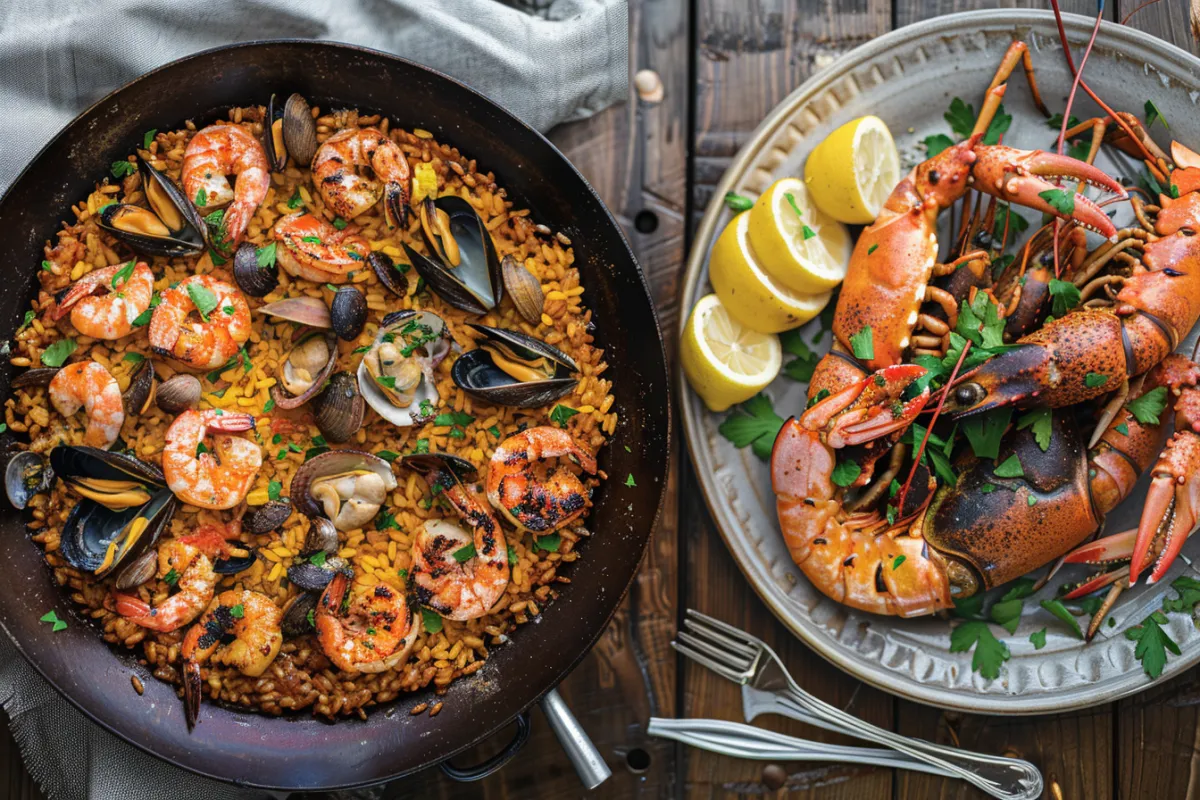Spanish cuisine is full of iconic and flavorful dishes, but two that truly stand out are paella and mariscada. Although both are seafood-based, they are very different in terms of ingredients, preparation methods, and cultural significance. If you’ve ever found yourself wondering, “What is the difference between paella and mariscada?”, you’re in the right place. Let’s explore the unique characteristics of each dish, diving into their history, cooking techniques, and flavors.
What Is Paella?
To understand the key differences, it’s important to start by explaining what paella is. Paella originates from the Valencia region of Spain and is traditionally cooked in a large, shallow pan over an open flame. This dish is well-known for its rich, flavorful rice that soaks up the spices and broth it’s cooked in, making it a truly indulgent meal.
History and Origins of Paella
The origins of paella go back to the countryside of Valencia, where farmers and laborers would cook rice over a wood fire. They would add any ingredients they had on hand, which often included rabbit, chicken, and sometimes snails. Over time, seafood became a common addition, especially in coastal areas.
- Paella’s birthplace: Valencia, Spain.
- Traditional ingredients: Rice, saffron, chicken, rabbit, and seafood.
- Paella’s communal nature: Historically, people would gather to cook and enjoy paella together, making it a social dish that often brings communities closer.
Types of Paella
There are several types of paella, and each one offers a unique experience.
- Paella Valenciana: The original version, which includes chicken, rabbit, and snails.
- Paella de Marisco: This version focuses entirely on seafood. It includes shellfish like shrimp, clams, mussels, and sometimes squid. The absence of meat distinguishes it from other varieties.
- Mixed Paella: As the name suggests, this is a combination of seafood and meat, blending the best of both worlds for a rich and diverse flavor profile.
Cultural Significance of Paella
Paella is more than just a dish; it’s a symbol of Spain. Across the globe, when people think of Spanish cuisine, paella often comes to mind. It’s a celebratory dish, frequently cooked for gatherings and festivals.
- International symbol: Paella is a staple in many Spanish restaurants around the world.
- Festive dish: Many Spanish festivals and family gatherings feature large pans of paella cooked over an open flame.
What Is Mariscada?
While paella is all about the rice, mariscada is a seafood extravaganza. This dish originates from the coastal regions of Galicia, in northwestern Spain, and it’s also popular in Portugal. Instead of rice, mariscada is essentially a seafood platter or stew, loaded with various shellfish.
What Makes Mariscada Unique?
One of the key differences between paella and mariscada is that the latter doesn’t focus on rice. Mariscada is all about fresh seafood, served either grilled, steamed, or in a light broth.
- Main ingredients: Lobster, shrimp, clams, mussels, and crab are the stars of mariscada.
- No rice base: Unlike paella, mariscada doesn’t rely on rice to complete the dish. It allows the seafood to take center stage, with minimal seasoning.
How Is Mariscada Prepared?
Cooking mariscada is simpler than paella. The seafood is usually steamed or boiled, which helps preserve its natural flavors. However, some variations include grilling the seafood or serving it in a flavorful stew.
- Steamed or boiled seafood: Cooking methods like steaming or boiling ensure the seafood retains its freshness.
- Minimal seasoning: Unlike paella, which includes saffron and other spices, mariscada focuses on the natural taste of the seafood.
- Varied presentations: It can be served hot or cold, often with side dishes like bread, potatoes, or a light broth.
Key Differences Between Paella and Mariscada
Now that we’ve explored both dishes, let’s discuss their main differences in terms of ingredients, flavor, and preparation methods.
Ingredients
- Paella: The base of paella is rice, flavored with saffron and spices. Depending on the variety, it can include seafood, chicken, or rabbit.
- Mariscada: Seafood is the star of mariscada, and there is no rice in this dish. It features shellfish such as lobster, shrimp, and mussels.
Flavor Profiles
- Paella: The flavor of paella comes from the saffron and spices used to flavor the rice. The seafood or meats added to the dish provide extra depth.
- Mariscada: With mariscada, the focus is entirely on the fresh taste of the seafood, which is often served with just a simple broth or melted butter.
Cooking Techniques
- Paella: Paella is typically cooked in a shallow pan. The rice absorbs all the flavors of the broth and spices, and a crispy layer known as socarrat forms at the bottom, adding texture.
- Mariscada: On the other hand, mariscada doesn’t require any special cookware. It’s either boiled or steamed, and in some cases, the seafood is grilled.
Regional and Cultural Context
- Paella: This dish is deeply tied to the region of Valencia but has become popular all over Spain and the world.
- Mariscada: Mariscada is closely associated with Galicia and Portugal, where seafood is a staple of the local diet.

Similarities Between Paella and Mariscada
Despite their differences, there are some similarities between paella and mariscada that are worth noting.
Shared Use of Seafood
Both dishes heavily feature seafood, especially shellfish like shrimp, clams, and mussels. In paella de marisco, the seafood is incorporated into the rice, while in mariscada, it stands alone.
- Seafood as a key ingredient: Both dishes rely on fresh seafood, and the quality of the seafood is critical to the dish’s overall success.
- Fresh shellfish: Lobster, shrimp, mussels, and clams are common to both dishes.
Communal Eating Tradition
Both paella and mariscada are intended to be shared. Whether it’s a large pan of paella or a seafood platter, these dishes are typically enjoyed in a communal setting.
- Paella for large gatherings: Traditionally cooked in huge pans, paella is meant to be shared with family and friends.
- Mariscada platters: Likewise, mariscada is often served as a large platter, designed for sharing.
Paella de Marisco vs Mariscada
To further explore the comparison, it’s essential to look at paella de marisco (seafood paella) and mariscada side by side. Both focus on seafood, but they remain fundamentally different dishes.
Paella de Marisco
Paella de marisco is one of the most popular variations of paella. While the rice remains central to the dish, the seafood takes over as the main protein. Shrimp, mussels, and clams are cooked with saffron-flavored rice, creating a rich, satisfying meal.
- Saffron-flavored rice: Even in its seafood version, paella relies on saffron and other spices to enhance the flavor of the rice.
- Seafood mixed in: The seafood in paella de marisco is cooked together with the rice, absorbing the spices and broth.
Mariscada’s Seafood Focus
In contrast, mariscada focuses purely on the seafood. It doesn’t include rice, and the seafood is often boiled or grilled, then served separately or with a light sauce.
- No rice: Mariscada features no rice, so the seafood shines on its own.
- Light seasoning: The seafood is prepared simply, with minimal seasoning to enhance the natural flavors.
How to Cook Paella vs. Mariscada
Whether you’re cooking paella or mariscada, the preparation is key to getting the best flavors from your ingredients. Here’s a step-by-step guide for each dish.
How to Cook Paella
- Use a wide, shallow pan to cook your paella.
- Sauté onions, garlic, and tomatoes until soft.
- Add saffron, smoked paprika, and other spices for flavor.
- Pour in rice and broth, letting it simmer until the rice absorbs the liquid.
- Add seafood like shrimp, mussels, and clams, letting them cook in the broth.
- Don’t forget to achieve the perfect socarrat (the crispy rice at the bottom of the pan).
How to Cook Mariscada
- Start with fresh seafood, such as shrimp, lobster, and clams.
- Boil or steam the seafood until it’s just cooked through.
- Serve the seafood with a light broth or sauce, or simply with lemon and herbs
- Garnish with fresh parsley and serve with bread or potatoes for a complete meal.
Nutritional Comparison of Paella and Mariscada
When it comes to nutrition, both dishes offer plenty of health benefits, but they do so in different ways.
- Paella: Because of the rice and oils used, paella is generally higher in calories. However, it provides complex carbohydrates and is quite filling.
- Mariscada: Mariscada is lower in calories but higher in lean protein, thanks to the abundance of seafood. It’s also rich in omega-3 fatty acids, which are great for heart health.
Popularity and Global Influence of Paella and Mariscada
Although both dishes have deep roots in Spain, they’ve achieved different levels of international fame.
Paella’s Global Reach
Paella has gained widespread popularity far beyond Spain’s borders. You can find paella restaurants in cities all over the world, and it’s often featured at food festivals and events.
- International dish: Paella is recognized globally as a staple of Spanish cuisine.
- Festivals: There are even festivals dedicated to cooking paella, where huge pans of the dish are prepared for large crowds.
Mariscada’s Regional Popularity
Unlike paella, mariscada remains more of a regional dish. While it’s incredibly popular in Galicia and Portugal, it hasn’t achieved the same level of global recognition.
- Regional specialty: Mariscada is a local favorite in coastal regions but less known internationally.
- Focus on seafood: Its emphasis on fresh seafood makes it a beloved dish for seafood lovers.
FAQs
What is the meaning of paella de marisco?
Paella de marisco refers to a seafood version of paella, where shellfish such as shrimp, clams, and mussels replace the traditional meats like chicken or rabbit.
What is the difference between paella de mariscos and paella Valenciana?
Paella Valenciana includes chicken, rabbit, and sometimes snails, while paella de marisco focuses solely on seafood, with no meat involved.
What are the three types of paella?
The three most common types of paella are:
- Paella Valenciana (made with chicken, rabbit, and vegetables).
- Paella de Marisco (seafood-based).
- Mixed Paella (a combination of both meat and seafood).
Conclusion: Which Dish Should You Try Paella or Mariscada?
When choosing between paella and mariscada, it ultimately comes down to what you’re in the mood for. If you love the combination of seafood and savory rice, go for paella de marisco. On the other hand, if you prefer a simpler dish that highlights the natural flavors of seafood, mariscada might be your best bet. Both dishes offer a unique taste of Spanish cuisine, so either way, you’re in for a delicious experience.

